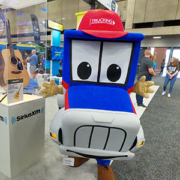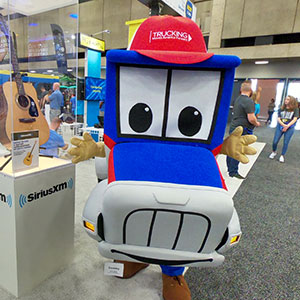By Deborah Lockridge
In some ways, the truck of the future is here today. What would a truck driver from decades ago think if he were suddenly transported from his own time into one of today’s state-of-the-art rigs?
Smooth, quiet rides. Automated transmissions. A voice giving turn-by-turn directions through in-cab speakers. Systems that warn if he’s wandered out of his lane or to slow down if he’s in danger of hitting the vehicle ahead. Tires that inflate themselves up automatically. The list goes on and on.
The Technology and Maintenance Council of the American Trucking Associations has been looking at the future since 1984. That’s when it founded its Future Truck program, which looks at what members want and expect in the trucks of tomorrow.
TMC is midway through the multi-year process of developing a new Future Truck position paper. We started with those results, then spoke with truck makers and others in the industry to bring you this list of things you can reasonably expect to see on trucks in the next five to 10 years or beyond.
1. Better fuel economy
More than half the fleets in TMC’s survey think we’ll see trucks achieving better than 9 mpg – a feat already being achieved by some fleets. Mike Jeffress, vice president of maintenance at Maverick Transportation, would like to see 10- to 15-mpg tractors. That’s not out of the realm of possibility.
Peterbilt is a partner in the Department of Energy’s SuperTruck project, which focuses on doubling the freight efficiency of tractor-trailer technology.
Peterbilt Chief Engineer Landon Sproull says its first-generation SuperTruck concept tractor-trailer achieved nearly 10 mpg. He expects even better performance out of the second-generation truck, which should be ready in the first quarter of 2014.
Fuel economy is being driven both by fleet demand and by federal regulations to reduce greenhouse gas emissions. The first tier of those GHG regs already is in effect for 2014 model year trucks. The next round of regulations, which are still being written, are expected to kick in starting in 2019, says Wade Long, Volvo Trucks director of product marketing.
As equipment makers move forward, Long says cruise power demand will decrease by at least 20% on average, pushing down optimum engine size and/or allowing for downspeeding.
“Decreased cruise power demand and potential for smaller engines could allow for optimizing cab aerodynamics,” he says, “either for a small engine with waste heat recovery or a larger engine without waste heat recovery.”
Expect more trucks to have a 6×2 axle configuration where the second axle in the drive tandem is a “dead” axle, and more direct drive instead of overdrive transmissions.
Expect more automated transmissions, both for fuel economy and widening the driver pool. TMC’s survey predicted above 60% usage of AMTs in Class 8 trucks as well as increasing use of hydraulic automatics – above 15% market share in Class 8 and above 70% in Class 6 and Class 7.
There already is, and will continue to be, an increasing focus on the powertrain as a whole, with the transmission, engine and axles all working together for the optimal fuel economy.
The next step will use data from outside and inside the truck to make drivetrains even more efficient.
Sproull believes that in three to five years, using technologies such as predictive cruise control, GPS and 3D mapping, “we’ll see improved predictability of the terrain to manage the vehicle for fuel economy.” In fact, he said, it’s already been demonstrated on the SuperTruck project.
Navistar is also heading in that direction, says spokesman Steve Schrier. “One unique technology that’s a couple years away is what I would refer to as a ‘smart cruise control system’ that takes into consideration a number of various factors like GPS data, topography, road data, etc. The system takes these variables and transforms them into formulas and algorithms and communicates with the truck’s ECM to apply (or not) the throttle based on approaching inclines and declines on the road.”
Peterbilt’s Sproull predicts the next set of regs will bring “a step change in terms of aerodynamics.” Efforts will focus more on the tractor-trailer as a whole, he says. Strategies will include managing the air flow between the tractor and the trailer, under the trailer and coming off the rear of the trailer.
Volvo’s Long agrees, and says if the EPA doesn’t bring trailers into the picture, California could mandate advanced trailer designs.
Brian Tabel, spokesman for Isuzu, believes we also will see medium-duty vehicles become more streamlined. Isuzu partnered with Supreme a few years ago to build a lightweight, composite and aerodynamic Aero Body. The Great Recession led to its discontinuation, but Tabel believes the idea will gain traction in the future.
There are many more ideas truck makers are working on to squeeze every last bit of fuel economy they can.
“We’re going to be trying to capture those bits and pieces of fuel economy improvement, because a lot of the low-hanging fruit has been captured,” says Scott Perry, Ryder’s VP of purchasing.
Long believes the next step of federal GHG regs will lead to the proliferation of low-rolling-resistance tires. You may even see such tires mandated for on-highway use, he says. And we’ll likely see continuing adoption of wide-based single tires for operations where it makes sense.
Lighter weight materials will save fuel and/or increase payload. The TMC survey suggested dynamic control of the trailer gap and fifth wheel height. We’ll likely see the demise of external antennas, as we already have on the Freightliner Cascadia Evolution. And cameras could replace rear-view mirrors, as they did on Freightliner’s Revolution concept truck.
Navistar’s Project Horizon concept vehicle at the 2013 Mid-America Trucking Show featured grille bars that open and close based on cooling demands. “The dynamic grille bars reduce aerodynamic drag by creating the right balance between the air entering the cooling module and traveling around the vehicle,” Schrier explains.
Idle reduction will continue to gain adoption as systems continue to improve.
Auxiliary power units, auxiliary heater units, battery-powered HVAC systems, auto start/stop battery management systems are all available right now, says Schrier, and will continue to gain traction in future trucks.
Battery-powered, diesel-powered, even fuel-cell-powered systems were seen as likely players by TMC survey respondents.
We could even see widespread use of solar power idle reduction, as eNow has already introduced.
2.‘Right-sized’ vehicles and engines
Fleets are realizing that they may be able to save fuel and upfront purchase costs by spec’ing a smaller or less powerful vehicle that more closely fits their needs, and that trend is likely to continue.
For instance, right now we’re seeing a move from 15 liters to 13 liters for Class 8 on-highway trucks. Jeffress wonders if engine designers eventually may work the same magic with 11-liter engines.
The same is true for the lower classes of trucks.
“Look at the horsepower and torque we’re getting out of a four-cylinder engine that’s delivering 200 horsepower and 285 or 300 pounds-feet of torque to do a job in a Class 5 vehicle,” says Todd Bloom, president and CEO of Mitsubishi Fuso Truck of America.
In medium-duty, many fleets are moving to smaller-class vehicles. Isuzu’s Tabel says people “are reevaluating how their trucks are driven. Something they would always use a Class 6 or 7 for, now they’re coming down to a Class 5. They’ve always bought big, heavy-duty trucks so they ensure they’ve got everything covered. Now they’re looking at how they can put more fuel-efficient trucks on different routes.”
Bloom describes this as a “trend to use the right vehicle for the right job.”
“Instead of getting more truck than you need so you’ll never be overloaded, it makes more sense to get that loaded 90% every day,” he says. “If you need more for the busy season, you can go out and rent what you need.”
3. Better durability and maintenance
By 2025, TMC fleet members say, we’ll see trucks that are more reliable.
• Oil change intervals may continue to increase, with TMC’s survey predicting oil change intervals of more than 60,000 miles.
• More fleets will go to air disc brakes, which take less maintenance than traditional drum brakes, with half saying it would be over 75%.
• TMC members predict 80% or greater usage of tire pressure monitoring and inflation systems, and a likely addition of tread depth sensors, to help tires last longer and save fuel.
• We will continue to see improvements in the electrical and battery area. Ultracapacitors are on the horizon, says TMC, and a switch to 24 volts is probable. We’re already on the way to all-LED lighting.
Computer technology, from electronic driver vehicle inspections to telematics, may play the largest role in improved vehicle uptime. Truck makers are now offering telematics systems that communicate between the truck, the dealer/OE and the back office about any problems happening on the vehicle.
“I think in the future, the truck will be able to understand, based on its duty cycle, when the usable life of the components on board is and when they need to be serviced,” predicts T.J. Reed, director of product strategy for Freightliner Trucks, and will communicate that to the maintenance manager.
Mike McQuade, chief technology officer for Zonar, predicts more telematics built into the truck. He foresees a day when the OE can analyze the data from each truck and tweak the programming over the air to make it operate more efficiently.
“We’re going to see aftermarket telematics be one thing, and factory-installed telematics be some level above that,” McQuade says. “Like supersizing your order or buying a loaded car, you’re going to get another level of connectivity, knowledge and value.”
4. Alternative fuels
“Beyond the next couple of years, we’re seeing a groundswell for alternative fuels, especially natural gas,” says Ryder’s Perry. “More investment is being made in engine platforms to expand that portfolio, and that competition drives further advancements on the technology standpoint and also drives cost out of the offering.”
Don’t count out other alternative fuels, such as advanced biofuels made from algae and other non-food stocks. Volvo and Mack believe DME, or dimethyl ether, is the fuel of the future. Hybrid, electric, propane, natural-gas-to-liquid, all will likely play a role in powering future trucks.
For medium-duty, TMC’s survey respondents felt it was likely that we would see gasoline-powered Class 6-7 trucks. Truck makers backed this up.
Isuzu’s Tabel says the traditional rule of thumb was that only trucks with 25,000 miles annually or less were a good candidate for gasoline. “Today we’re seeing customers that have 25,000, 30,000, even 35,000 miles a year and they can still make sense of gas, because they don’t have the added costs of diesel emissions requirements, DPF filter cleanings or DEF fluid,” he says.
5. Changes in the cab
Expect more integration of in-cab technology into the OE dashboard. Both Freightliner and Peterbilt have showed concept trucks featuring a removable tablet in the dash that can display virtual gauges, navigation and instantaneous feedback on fuel economy and unsafe driving. The tablet can be removed when the truck is not in motion to perform electronic vehicle inspections or for the driver to use to connect with family members or other personal use.
Daimler recently took a step in that direction with its Detroit Connect tablet. It pops into a cradle rather than being built into the dash as those concept trucks, but it performs many of the same functions, offering telematics, diagnostics, navigation, hours of service and more.
Sleepers may get smaller as more fleets move to regional haul or hub and spoke type operations.
Freightliner’s Revolution concept truck totally re-envisioned the cab interior for these types of operations. It’s somewhat like an extended cab, with a sleeper berth that folds up. The passenger door or passenger seat have been left out in order to create a driver work area.
Driver productivity and satisfaction drove many of the interior features of the Revolution, including small things like mood lighting and an integrated coffeemaker.
OEs have been paying a lot of attention to driver comfort and convenience in their latest trucks. The focus on ergonomics may continue as fleets face a worsening driver shortage. We could see more adoption of driver comfort options such as the Bose Ride system, a seat that uses “intelligent motion” technology to improve driver comfort and reduce fatigue.
6. More safety features
We’ll almost certainly see more penetration of high-tech safety systems such as collision avoidance, lane departure warning, rollover prevention and stability control, says Ryder’s Perry. “CSA has definitely driven that from the accountability standpoint.” They may well be mandated by the federal government some day.
TMC’s survey predicts greater than 80% usage of lane departure warning systems and collision warning/mitigation systems. They believe we’ll see over 60% usage of blind spot monitors, and more than 40% usage of cameras monitoring the driver.
These features will continue to improve and add more capabilities and integration with other systems in the coming years. SmartDrive, for instance, recently announced integration of its camera-based system with collision mitigation systems from third-party suppliers.
Maverick’s Jeffress speculates that the advanced systems we see today could perhaps be paired with even more advanced computer algorithms that operate intelligently based on the individual driver.
“If a system can prevent you from following closer than, say, 3 seconds, then it should be able to learn an operator’s habits and adjust accordingly,” he says.
Safety innovations aren’t always about computers. Navistar, for instance, showcased a corner illumination lamp on its Project Horizon truck, which is automatically activated with the turn signal. As the driver signals to turn, four corner LED lights are activated, illuminating the corner to provide the driver increased visibility before the turn.
7. More medium-duty cabovers
Fuso’s Bloom predicts we’ll see an increase in medium-duty cabovers for urban applications, while vocational trucks will largely still be conventionals. In fact, he sees the re-entry of more low cabovers in the Class 6 and 7 market, thanks to their maneuverability, sightlines and overall efficiencies in an urban environment.
Kenworth’s Class 6 K270 and Class 7 K370 cabover medium-duty trucks, introduced about 18 months ago, are making far more inroads into the market than the company’s previous forays into this segment, say company officials.
Doug Powell, medium-duty marketing manager, says these trucks are better suited to the North American market than the company’s previous attempts.
“We’re really pushing our dealers to interview the customer to really see what’s best for their application,” he says. “In a lot of cases the K370 will work better than the [conventional] T370.”
8. Connected vehicles and highways
We delve into this topic more in this article by HDT’s Jim Beach – the idea of vehicles communicating with each other and with the infrastructure. TMC members believe vehicle-to-infrastructure communications are likely. (We already see a version of this with automated tolling and weigh station bypass systems.) Wireless communications between the tractor and trailer are seen as likely in the survey, and vehicle-to-vehicle communications are seen as probable.
Brian Heath at Drivewyze, which offers a smartphone-based weigh station bypass system, says weigh-in-motion and hours-of-service information could be exchanged wirelessly as the truck travels down the highway.
Looking further out, we could even see driverless vehicle platooning, the TMC survey says.
“The concept of driverless vehicles has intrigued me for many years,” says Maverick’s Jeffress. “What would a driverless tractor look like? Think of all the parasitic loads that could be removed – no need for HVAC, for instance. What would the efficiency of that second or third vehicle [in a platoon configuration] actually be? How does this thought process tie back to the safety technology advancements as well as CSA?”
Peterbilt’s Sproull says while autonomous vehicles are “a long way out, the technology is there. Demonstration vehicles today are showing that’s very feasible.” In fact, Peterbilt is involved in a platooning test project.
Freightliner’s Reed predicts that while we will continue to see active safety systems improve, trucks still need drivers for the foreseeable future. In the meantime, he says, “How can we help the folks behind the wheel be more effective – to be the safest, most fuel-efficient they can be?”
For some really far-out concept trucks, check out this photo gallery at: www.truckinginfo.com/futuretrucks.


